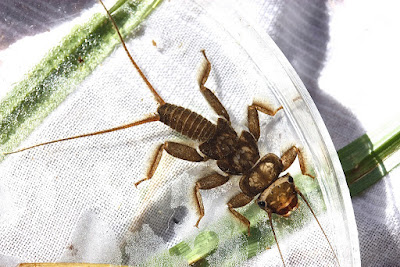It's the kind of day -- cold and overcast -- when I normally forego taking photos, but I changed my mind when I collected this little nymph. A fully mature small winter stonefly, Allocapnia pygmaea, female. The leafpacks are full of these nymphs at the moment. Not my best photos, but nice enough to share.
Tuesday, February 6, 2018
The small winter stoneflies are filling our streams
It's the kind of day -- cold and overcast -- when I normally forego taking photos, but I changed my mind when I collected this little nymph. A fully mature small winter stonefly, Allocapnia pygmaea, female. The leafpacks are full of these nymphs at the moment. Not my best photos, but nice enough to share.
Monday, February 5, 2018
Acroneuria colors: I still get surprised.
I came upon this photo the other day when reviewing my files and immediately concluded it was the common stonefly, Acroneuria abnormis. The reason is simple. A. abnormis nymphs, in my mind, are always this color of brown. For example...
True, as with the nymph in this photo, they often have terga that are banded, but still the basic color is brown. And, you may recall, on some nymphs the terga are totally brown.
Closely related to A. abnormis is A. carolinensis. Both species have a light "M" pattern on the head, lack a row of setae at the back of the head, and A. carolinensis nymphs also have banded terga.
But A. carolinensis nymphs, as you can see are basically yellow or orange.
So it appears to be easy to tell them apart by seeing the color. The nymph at the very top of the page is basically brown, so it must be A. abnormis -- right? Wrong, and I should have known better. It is morphology that we have to use in determining species; pigment is an unreliable character. And "morphologically," abnormis and carolinensis nymphs differ in one important respect -- the banding shades are reversed. On A. abnormis nymphs, the dark band is in front, the light band at the back, on A. carolinensis, it's just the opposite.
Back to our nymph at the top of the page.
Yes, it's basically brown, but look at the terga. This nymph is A. carolinesis. And, we can find the same with A. abnormis.
Basically yellow, but the lighter bands on the terga are at the back. It's A. abnormis.
Just a reminder, don't be too quick to jump to conclusions, and I've been guilty of this. True, the color's a good indication, but the tergal banding is the key thing to use.
Subscribe to:
Posts (Atom)











